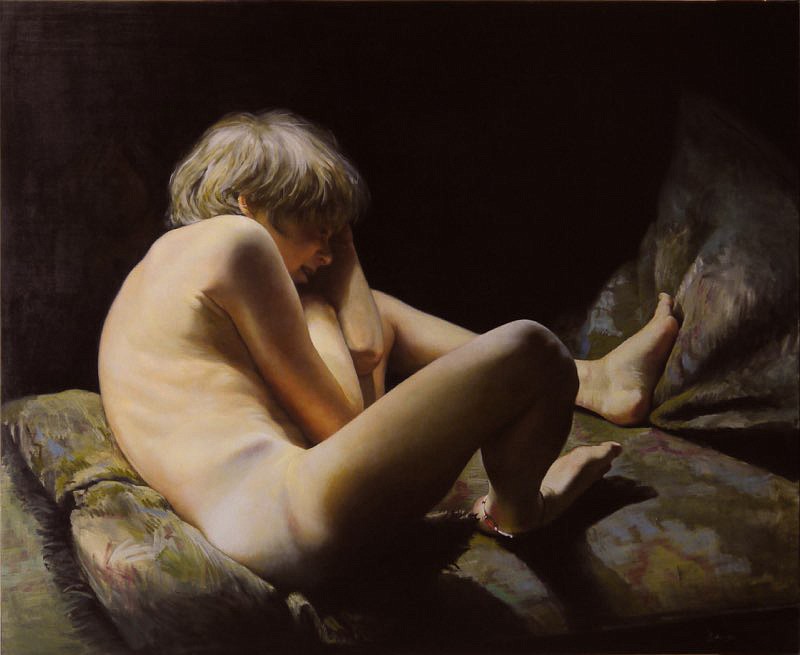- April 24, 2024
-
-
Loading

Loading

His gaze is different than the rest of them. Instead of looking at the viewer like the other subjects, Dillon holds his purple-encased iPhone and points it at his viewers while a skinny green paintbrush dangles from his mouth. Or is he pointing it at himself? His dark, untamed hair sits atop his head in a messy bun, and he looks into his front-facing camera with a look of tired concentration.
Do artists view the world differently? It’s a complex concept. The painting described above, “Dillon: Portrait of the Artist As a Young Man,” by Grace Graupe-Pillard, is a portrait of a waiter at a diner the artist used to frequent. Her fascination produced a striking image that represents the way artists can use their work to not only share their perspective, but also to potentially challenge those of their viewers.
Mark Ormond, curator for exhibitions at Ringling College Galleries, included this in his most recent exhibit, “Observation/Reference/Gesture Contemporary Paintings.” The exhibit, which runs through Dec. 2, at the Willis Smith Gallery, challenges people to examine the objects and people they encounter on a daily basis.
A Second Look
For Ormond, several of the paintings are a nod to the modern trend of treating cellphones like vital organs.
“Now, where the camera is literally a part of everyone, artists are free to use it for reference and to make it part of their process,” he says. “It has become part of their process to some extent, even if it’s just for catching observations.”
One featured artist who uses photography as an observational tool is Dustin Juengel, faculty member at Ringling College. Juengel is the creator of “Untitled (Lemur),” an oil painting he created for a fundraising calendar for the Lemur Conservation Foundation in Myakka City.
All of his work is based on photographs, so Juengel began the process when he went to the lemur reserve and took several hundred photographs of lemurs that he observed. He narrowed the photos down to one that showed the potential to make a unique portrait and used projections to create a preliminary drawing before finally putting paint to canvas.
Juengel was drawn to the way the lemur was seated with leaves in the foreground and ample vegetation surrounding him. This, he says, was mostly due to chance, but he likes that his photography is not controlled — he simply photographs what he observes. He takes control, he says, when he picks up his paintbrush.
He says the photos help him stay focused and mark his progress.
“As opposed to working from imagination, I like to give myself a goal or at least something that I’m referencing to know if I’m achieving what I’m looking for,” he says. “If I painted from imagination, the image in my head would change, and I like to have a solid foundation.”
Ormond is interested in Juengel’s work because he thinks the final product, though it was based off a photograph, deviates from reality in a way that can allow the viewer to appreciate the labor that went into it. When he looks at Juengel’s work, he says, he can see the brush strokes and is reminded of the hours of painstaking effort it took to complete.
Valuing the Subject
The way he speaks about Juengel’s art is similar to the way he describes “Brush” by Jeffrey Ripple, another work on display in the exhibit.
In this painting of a paintbrush, he sees much more than an artistic tool nailed to a wall. He sees every bristle as an individual with its own personality, and he views the whole brush as part of a larger narrative — then he begins to ponder the story of how old it is and where it’s been.
Juengel and Ormond hope that this exhibit will slow people down, especially in a world where everyone seems to crave images instantly. They hope that by looking at these pieces and contemplating the craftsmanship that went into them, viewers might begin to appreciate both the time-intensive work of the artists and the stories they were trying to tell.
“There is so much going on in an artist’s mind that informs what we see,” he says. “It’s not just what, in a photograph, would be one frame. It’s hours of experience with the object of the canvas and then also the hours that the artist spent thinking about it that informs what we see.”